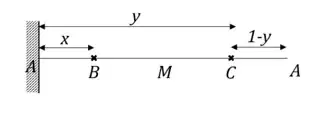Without loss of generality, we can assume the circumference of the circle to be equal to $1$. Cut the circle at the first point $A$ and spread it out as a line. Let the other two points $B$ and $C$ be located at distances of $x$ and $y$ from $A$. The midpoint of this line is $M$ and $0 \leq x,y \leq 1$.

Points $B$ and $C$ can be both located on same side of $M$ or on either side of $M$. If both points lie on the same side of $M$, then all $3$ points lie on the same semi-circle.
$$
P(\text{same side}) = 2 * \frac{1}{4} = \frac{1}{2}
$$
We are multiplying by 2 as the points can lie on both sides of $M$.
They can also be located on the either side of $M$ and in this case, the conditions for all 3 points to lie on the same semi-circle are
$$
x + 1 - y < 0.5 \Rightarrow y > x + 0.5 \text{ if } y > x\\
y + 1 - x < 0.5 \Rightarrow x > y + 0.5 \text{ if } x > y
$$
Representing these two regions graphically, we get the following area:

The area of the shaded region is $\frac{1}{4}$. Combining all results, we get the probability that $A$, $B$ and $C$ all lie on the same semi-circle is
$$\frac{1}{2} + \frac{1}{4} = \frac{3}{4}$$.

